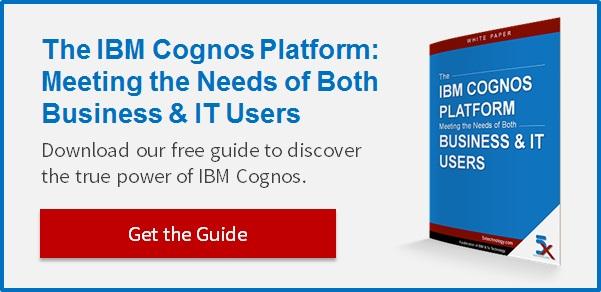As your business grows, building a data warehouse can often feel like drinking from a fire hose.
Incomplete data and the fear of managing changing dimensions can lead to challenges difficult to overcome. But having an ETL developer that knows how and when to use IBM Cognos can prevent time lost and budget spikes.
As your company continues to grow, so does the volume of data. That's why having both a tool like IBM Cognos and an ETL developer that knows how to use IBM Cognos tools can prove to be valuable. It's time to embrace both so that the work that goes into designing and building data warehouses is extended to how the data is distributed for reporting to all levels in the company. An ETL developer that has the necessary IBM Cognos training can harness all of the data for clean, personalized dashboard reporting that functions as a valuable Business Intelligence tool.
What does IBM Cognos Do?
IBM Cognos is a tool for Business Intelligence, which means you have full dashboard and analytics capabilities. The issue with IBM Cognos is that it’s not the kind that you can just pick up from scratch. It’s not exactly a plug and play type of service.
You have to understand what you’re doing at a deep level to get the most out of it. It’s a highly versatile tool with abilities include the following:
- Creating Reports: IBM Cognos produces professional reports with all of the extras that go with it like using templates so that you don’t have to go back to square one every time. The reports also includes the ability to customize based on what you need for your developer job since the tool is larger than developers. IBM Cognos reports are much different than SAP reporting. Here's a quick overview of their differences.
- Modeling Data: IBM Cognos allows you to shape data. By shaping the data, developers can take from multiple numbers of sources or push this data to sources. This might include sources such as files that you upload, servers for data, and elsewhere. The IBM Cognos tool is useful for ETL developers because it allows you to define terms directly and gives you more control over what comes out.
- Locating Content: You want to avoid spending too much time hunting around for data content you need to put together into a palatable form, and those properly trained on the use of this tool will be able to do this. Everything from stories to normal data, folders, files reports, specific dashboards, and many other things are all easy to locate with the search tool. That way you won’t have to check the my content folder which can be a tedious and overly long way to do it.
This is just the beginning of what the tool can do for ETL developers. The option to take data and export it allows for quicker administration to parts of the tool. This helps speed up feedback from other internal team members and leaders.
What Is the ETL Developer’s Role in IBM Cognos?
The primary role of an ETL developer when using the IBM Cognos tool is shaping the data organized and produced so that anyone can quickly take it and work with it no matter how they need to do so. Obviously, this can be a difficult proposition because there will be many different people consuming the data, so it needs to come out in a way that’s not overly complicated.
Shaping the data so that it can be utilized by others is a part of the life of a developer that is often downplayed, but Cognos makes this easier for developers to accomplish. That would be why it’s an important tool for a developer to learn and master.
Why Do ETL Developers Need IBM Cognos Training
IBM Cognos training such as the Overview of IBM Cognos Analytics course is essential to ETL developers because it will provide a better understanding of what can be accomplished with this critical tool that ETL developers need, and it provides a training path that’s geared specifically for developers.
The course starts from the beginning with a description of the tool, each of its components, its architecture and how the security works with a lot of depth. Then, provides the insight and training for how internal stakeholders read the data that is put out, how to create reports, how to handle dashboards, do modeling, and other important aspects of using the tool from an ETL developer’s point of view.
It's important to clarify that it teaches how to use Cognos as ETL developer to shape data into reports, for example. This will include many multiple aspects of report creation, which will at least be touched upon. The course teaches how to do things like handle subscriptions, design cubes, model in web-based environments, and many more skills that will aid you in shaping the data transferred by the ETL developer.
After the overview course, there are further paths that allow a continuation of knowledge building and skills to find more ways to maximize Cognos as a developer.
For example, if a developer wants to learn about Framework Manager, there are courses for that. Similarly, there are courses that focus on metadata models, OLAP models, or Dynamic cubes. In other words, all of the topics touched upon in the overview course have a more advanced training path so developers can get the training that relates to what they will be doing with Cognos.
Final Notes on the Benefits of IBM Cognos Training for ETL Developers
Many courses are partially self-paced, allowing for flexibility without feeling pressured. Some may allow a complete online course. The primary benefit of this approach is that you will receive the right training, without guesswork, by the professionals that work with it every day. IBM Cognos training is the key to taking your knowledge as an ETL developer to the next level and brings even further value to what the role provides to a business. It completes the data cycle beyond organizing it and provides a tool to communicate what the data means so the goals of the business can be forecasted, strategized, and measured.




